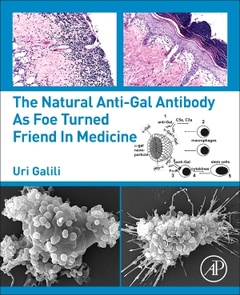The Natural Anti-Gal Antibody as Foe Turned Friend in Medicine
Auteur : Galili Uri

The Natural Anti-Gal Antibody as Foe Turned Friend in Medicine provides a comprehensive review of the natural anti-Gal antibody, which is the most abundant antibody in humans constituting ~1% of immunoglobulins and the carbohydrate antigen it recognizes, the a-gal epitope. It discusses the discovery of this antigen/antibody system, its evolution in mammals, the pathological effects of this antibody, and its possible use in various therapies in humans. Most significantly, the book discusses microbial and regenerative therapies in which an antibody present in all humans may be harnessed as an in vivo pharmaceutical agent that enables a wide variety of therapies.
Some of these therapies are described as experimental studies that are compiled in this book, other already studied therapies in the area of cancer immunotherapy are also included in this book.
SECTION 1: ANTI-GAL BACKGROUND1. Anti-Gal in humans and its antigen the a-gal epitope2. Why do we produce anti-Gal: Evolutionary appearance of anti-Gal in Old World primates3. Anti-Gal comprises most of anti-blood group B antibodies: Landsteiner’s enigma4. Anti-Gal interaction with Trypanosoma, Leishmania and Plasmodium parasites5. Anti-Gal B cells are tolerized by a-gal epitopes in the absence of T cell help
SECTION 2: ANTI-GAL AS FOE6. Anti-Gal and other immune barriers in xenotransplantation7. Anti-Gal IgE mediates allergies to red meat8. Anti-Gal and autoimmunity
SECTION 3: ANTI-GAL AS FRIEND9. Anti-Gal mediated amplification of viral vaccine efficacy 10. Cancer immunotherapy by anti-Gal mediated in situ conversion of tumors into autologous vaccines11. Anti-Gal as cancer cell destroying antibody and as antibiotics targeted by a-gal bi-functional molecules12. Acceleration of wound and burn healing by anti-Gal/a-gal nanoparticles interaction
SECTION 4: FUTURE HYPOTHETICAL DIRECTIONS13. Anti-Gal and anti-non gal antibodies in regeneration of extracellular matrix (ECM) bio-implants in humans 14. Post infarction regeneration of ischemic myocardium by intramyocardial injection of a-gal nanoparticles15. Regeneration of injured spinal cord and peripheral nerves by a-gal nanoparticles16. Inhalation of a-gal/sialic acid liposomes for decreasing influenza virus infection
- Provides tactics on how to improve cancer immunotherapy and viral vaccine immunogenicity
- Includes discussions on therapies that accelerate the healing of normal and chronic wounds, and of burns
- Covers the regeneration of bio-implants
Date de parution : 09-2017
Ouvrage de 304 p.
19x23.3 cm
Thèmes de The Natural Anti-Gal Antibody as Foe Turned Friend in... :
Mots-clés :
α1, 3-galactosyltransferase, α-Gal epitope, α-Gal liposomes, α-Gal nanoparticles, α-gal-like epitopes, Achilles' ADCC, Allograft, Anterior cruciate ligament, Antibody, Anti-carbohydrate antibody, anti-Gal antibody, Anti-Gal barrier, Anti-Gal, anti-Gal, Antigen presenting cells, Antigen, Anti-protein antibody, BHK, Bifunctional, Bio-engineering, Bio-implants, B-like antigen, Cardiomyocytes, Cetuximab, Chagas' Chagasic patient, CHO, Crohn's disease, Demyelination, disease, ELISPOT, Endoneurial tubes, Epitope, Extracellular matrix, Fc/FcγR interaction, Flu, Fucosyltransferase, Glycobiology, Glycoproteins, Glycosyltransferase, Graves' GT-KO mice, Haemophilus influenza, Half-life, heel, Hemagglutinin, Hyperacute, Immunohistology, Immunosuppressive, Intramyocardial injection, Intravascular thrombosis, Ischemic myocardium, Knockout, Liposomes, Macrophages, Melibiose, Metastatic tumor cells, Micrometastases, Morbidity, Mortality, Mutations, Nanoparticles, Neoadjuvant, New World monkey, Nonprimate mammals, Nonself carbohydrate antigens, Opsonizing, Peripheral nerve, Pinocytosis, Plasmapheresis, Platelet aggregation, Post-MI, RBC, RGD, Ribi, Saline-treated wounds, SELEX, Sialic acid, Sialidase, Sialyltransferases, Single strand, Spinal cord, Staphylococcus aureus, Streptococcus, Tolerize, Transection, Tripeptide, Trypanosoma cruzi, Tumor-associated antigens, Vasodilation, Xenotransplantation
